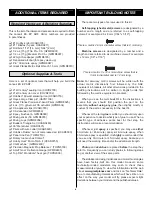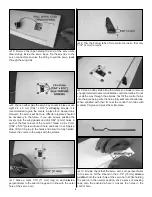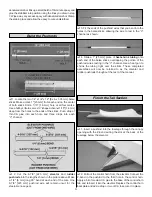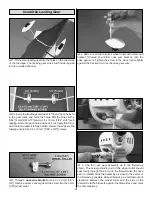
2
INTRODUCTION ...............................................................2
AMA...................................................................................2
SAFETY PRECAUTIONS..................................................3
DECISIONS YOU MUST MAKE ........................................3
Radio Equipment.........................................................3
Charger .......................................................................3
ADDITIONAL ITEMS REQUIRED.....................................4
Required Hardware & Building Supplies .....................4
Optional Supplies & Tools ...........................................4
IMPORTANT BUILDING NOTES ......................................4
ORDERING REPLACEMENT PARTS ..............................5
METRIC CONVERSIONS .................................................5
COMMON ABBREVIATIONS............................................5
KIT INSPECTION ..............................................................6
KIT CONTENTS ................................................................6
BEFORE YOU BEGIN .......................................................7
ASSEMBLE THE WING ....................................................7
ASSEMBLE THE TAIL SECTION......................................9
Install the Stabilizer .....................................................9
Build the Pushrods ....................................................11
Finish the Tail Section ...............................................11
ASSEMBLE THE FUSELAGE.........................................13
Install the Radio Tray & Wing Joiner Tube.................13
Assemble the Landing Gear......................................14
Install the Landing Gear ............................................15
Install the Radio System & Battery ...........................16
FINISH THE MODEL .......................................................17
Attach the Wing Panels .............................................17
Attach the Canopy & Cowl ........................................18
Attach the Propeller & Spinner..................................19
Apply the Decals .......................................................19
GET THE MODEL READY TO FLY .................................19
Check the Control Directions ....................................19
Set the Control Throws..............................................19
Balance the Model (C.G.)..........................................20
Balance the Model Laterally......................................20
PREFLIGHT.....................................................................20
Identify Your Model ....................................................20
Charge the Batteries .................................................21
Balance the Propellers ..............................................21
Ground Check ...........................................................21
Range Check.............................................................21
MOTOR SAFETY PRECAUTIONS .................................21
AMA SAFETY CODE (excerpts)....................................22
General......................................................................22
Radio Control ............................................................22
CHECK LIST ...................................................................22
FLYING ............................................................................23
Speed Control Set-Up ...............................................23
Takeoff .......................................................................23
Flight..........................................................................23
Landing......................................................................23
The Great Planes Lancair ES EP ARF is a quick building
scale park flyer that has everything you need except radio
and servos to get you into the air in about 4 to 6 hours. A
4-channel radio, with four micro servos and a micro receiver,
provides aileron control as well as a steerable nose gear.
Fiberglass fuselage, wheel pants, cowl, and wing tips
recreate the unique contours of the Lancair ES as well as
easing the assembly.
Flying the Lancair ES EP ARF is extremely smooth and
predictable. Takeoffs are scale-like with graceful flaring of the
nose as the model generates air speed. Landings allow a soft
touch down on the main wheels first, with the plane slowly
settling back down on the nose wheel as it slows to taxi speeds.
Even with a short 43 inch [1090 mm] wingspan, the Lancair ES
EP ARF demonstrates the steady flight characteristics of larger
models and will surely be an attention-getter at the flying field.
For the latest technical updates or manual corrections to the
Lancair ES EP ARF visit the Great Planes web site at
www.greatplanes.com. Open the “Airplanes” link, then
select the Lancair ES EP ARF. If there is new technical
information or changes to this model a “tech notice” box will
appear in the upper left corner of the page.
We urge you to join the AMA (Academy of Model
Aeronautics) and a local R/C club. The AMA is the governing
body of model aviation and membership is required to fly at
AMA clubs. Though joining the AMA provides many benefits,
one of the primary reasons to join is liability protection.
Coverage is not limited to flying at contests or on the club
field. It even applies to flying at public demonstrations and
air shows. Failure to comply with the Safety Code (excerpts
printed in the back of the manual) may endanger insurance
coverage. Additionally, training programs and instructors are
available at AMA club sites to help you get started the right
way. There are over 2,500 AMA chartered clubs across the
country. Contact the AMA at the address or toll-free phone
number below.
IMPORTANT!!! Two of the most important things you can do
to preserve the radio controlled aircraft hobby are to avoid
flying near full-scale aircraft and avoid flying near or over
groups of people.
Academy of Model Aeronautics
5151 East Memorial Drive
Muncie, IN 47302
Tele: (800) 435-9262
Fax (765) 741-0057
Or via the Internet at:
http://www.modelaircraft.org
AMA
INTRODUCTION
TABLE OF CONTENTS



































